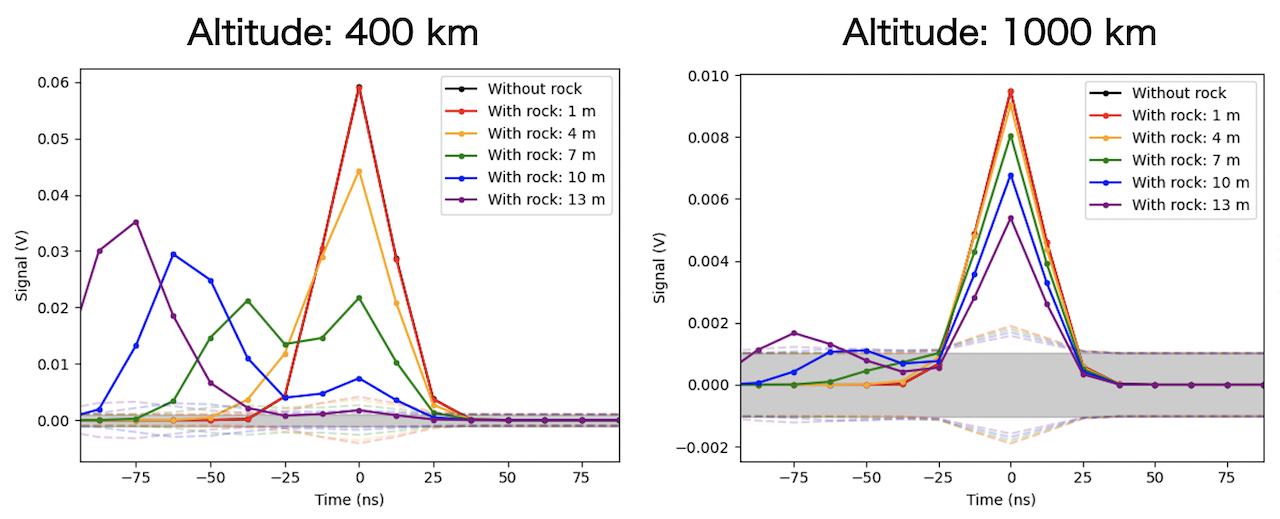Simulation of laser pulse shapes received by the BepiColombo Laser Altimeter (BELA): Implications for future constraints on surficial properties of Mercury
- 1Institute of Planetary Research, German Aerospace Center (DLR)
- 2Department of Earth and Planetary Science, Graduate School of Science, The University of Tokyo
- 3Instituto de Astrofísica de Andalucía, CSIC, Glorieta de la Astronomía
- 4Physikalisches Institut, University of Bern
Introduction
The ESA/JAXA joint mission BepiColombo comprises two spacecraft, one of which is the Mercury Planetary Orbiter (MPO). It will arrive at the Mercury orbit in 2025, and the BepiColombo Laser Altimeter (BELA) onboard MPO will start to characterize the Mercury’s surface, such as topographic reliefs. During the nominal and extended operations, the whole surface of Mercury will be covered by the BELA footprints, and separations between neighboring tracks were expected to vary from 3 km at the equator down to less than 250 m in polar regions [1].
One of the scientific objectives of BELA is to measure surface roughness, local slope, and albedo variations of Mercury [2]. In general, laser altimetry is a useful remote sensing tool to reveal the surficial features because the shape of the received pulse contains various information about footprints. For example, vegetation structure within footprints was observed in the waveforms measured by the Ice, Cloud, and land Elevation Satellite (ICESat) [3], and the martian roughness was estimated from the pulse width received by the Mars Orbiter Laser Altimeter [4]. Thus, BELA is expected to help characterize geologic features on Mercury, such as hollows [5]
In contrast, the effects of surficial features on the BELA pulse shape have not been investigated numerically. Until recently, semi-analytical pulse shape models have been employed to demonstrate the BELA measurements after the operation starts [1, 6]. Therefore, we develop the procedure to simulate realistic pulse shapes, incorporating digital terrain models (DTMs) and noise data from previous in-cruse checkouts of BELA. Then, we discuss the detectability of the surficial properties of Mercury.
Method
To simulate the realistic pulse shape returning from the Mercury surface, we first numerically model pulses returning from DTMs. Assuming a Gaussian pulse transmission and a Lambertian surface, we integrate photons from all the facets. Then, after the pulse shape is widened by the receiver optics, the number of photons is converted to signals in the avalanche photodiode. With 16 gain channels ranging from 4 to 44 dB, the Analog Electronics Unit amplifies the signal.
The simulated signal is finally compared with the sum of dark, solar, and shot noises. Data from in-cruise checkouts by June 2021 is used as the dark noise for respective gain channels. The solar and shot noise levels are analytically estimated [1]. By incorporating these noises, the signal-to-noise ratio (SNR) of the received pulse is calculated for various surfaces.
Results and discussions
Figure 1 shows pulse shape examples simulated with various ideal topographies. For the flat surface, time of flight is almost uniform for all the photons from the footprint. However, slopes change distances between facets and BELA, widening pulse shapes. If bimodal height distribution, such as depression, cliff, and rocks, is contained within the footprint, a split pulse can be detected, depending on the height gaps.

Figure 1. Pulse shapes returning from a flat surface, slope (20 degrees), and round depression. The altitude is set to be 1000 km above the Mercury surface.
Detectability of rocks within a footprint is also examined in our analysis. Locating a hemispherical rock on a flat plain and changing its radius, we calculated pulse shapes with two peaks from the rock and its surroundings (Figure 2). In order to receive the rock’s signal with an SNR of 1 or higher, our estimate suggests that the radius of the rock needs to be larger than a few meters at an altitude higher than 400 km.

Figure 2. Pulse shapes without noises simulated for hemispherical rocks with various radii. Black shades show a standard deviation of dark noise. Dashed lines show the sum of dark, shot, and solar noises. Left peaks correspond to laser pulses reflected by the rock surface.
Furthermore, roughness estimation within the footprint requires accurate slope values because they similarly widen the pulse shape. Although only one-dimensional slopes can be constrained with BELA, possible constraints on roughness will be estimated using these pulse shape simulations. This presentation will report on such further implications for Mercury’s surfaces in future BELA observations.
Acknowledgment
This research is granted by JSPS Overseas Challenge Program for Young Researchers.
Reference
[1] G. Steinbrügge, A. Stark, H. Hussmann, K. Wickhusen, J. Oberst, The performance of the BepiColombo Laser Altimeter (BELA) prior launch and prospects for Mercury orbit operations. Planetary and Space Science. 159, 84-92 (2018).
[2] N. Thomas et al., The BepiColombo Laser Altimeter. Space Sci Rev. 217(2021).
[3] D. J. Harding, C. C. Carabajal, ICESat waveform measurements of within-footprint topographic relief and vegetation vertical structure. Geophysical Research Letters. 32, L21S10-n/a (2005).
[4] G. A. Neumann et al., Mars Orbiter Laser Altimeter pulse width measurements and footprint-scale roughness. Geophysical Research Letters. 30, 1561-n/a (2003).
[5] T. Blewett David et al., Hollows on Mercury: MESSENGER Evidence for Geologically Recent Volatile-Related Activity. Science. 333, 1856-1859 (2011).
[6] A. HosseiniArani et al., Comprehensive in-orbit performance evaluation of the BepiColombo Laser Altimeter (BELA). Planetary and Space Science. 195, 105088 (2021).
How to cite: Nishiyama, G., Stark, A., Hüttig, C., Hussmann, H., Gwinner, K., Hauber, E., M. Lara, L., and Thomas, N.: Simulation of laser pulse shapes received by the BepiColombo Laser Altimeter (BELA): Implications for future constraints on surficial properties of Mercury, Europlanet Science Congress 2022, Granada, Spain, 18–23 Sep 2022, EPSC2022-326, https://doi.org/10.5194/epsc2022-326, 2022.

